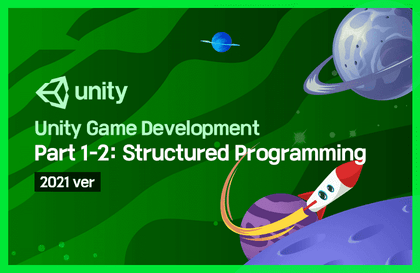
유니티를 위한 C# 기초 프로그래밍-구조지향(무료)
UDevApp
유니티를 위해서는 C# 프로그래밍이 필요합니다. 그리고 C# 프로그래밍은 객체지향과 구조지향의 프로그래밍으로 나뉩니다. 이 강의에서는 기초 C#프로그래밍 학습에 대한 기초적인 내용을 소개하고 있습니다.
입문
C#
C#을 실행하기 위한 유니티의 기초적인 인터페이스
유니티의 C# 기초 프로그래밍
프로그래밍을 하기 위한 컴퓨터의 기본동작과 구조
비전공자 & 입문자를 위한 게임 개발!
C# 프로그래밍 입문으로 게임 개발의 첫걸음을 떼보세요.

게임을 만들기는 지금까지 아주 어려운 일로 인식되어 왔습니다. 하지만 유니티와 같은 게임엔진의 발전으로 이제 1인개발자도 게임을 개발하는 것이 가능해졌습니다. 유니티 게임엔진을 배포하는 유니티 테크놀로지는 다음과 같은 캐치프라이즈를 내걸고 있습니다.
“배우기 쉬운 게임엔진”
하지만 비전공자들에겐 이것은 그림의 떡입니다. 게임엔진을 통한 게임 개발에 꼭 필요한 핵심 능력이 있기 때문입니다. 바로 프로그래밍입니다. 프로그래밍 기술이 없이는 게임을 만들수 없습니다. 또한 프로그래밍은 배우기 아주 난해합니다. 배우기 쉬운 게임엔진이라는 캐치프라이즈는 원래 게임을 개발하던 이들에게 적용되는 문제입니다. "배우기 쉬운" 이라는 요건을 충족시키기 위해서는 프로그래밍의 능력이 절실히 필요합니다.
그러한 문제를 해결하기 위해 이 강좌를 만들었습니다.
게임개발에 앞서 유니티에만 필요한 기능을 소개하면서 유니티로 학습해 나가는 C# 프로그래밍 강의입니다.
비전공자는 게임을 개발하기 시작하면 방대한 양의 공부를 해야 합니다. 우선 프로그래밍입니다. 유니티의 기능도 필요합니다. 어느 정도가 필요한지 알 수 없기에 무조건 배웁니다.
C#의 경우도 같습니다. 책에 있는 C#의 기능을 학습하려면 방대한 분량의 학습이 필요합니다. 하지만 그렇다고 너무 적은 부분을 공부하면 원리를 모르기 때문에 응용이 불가능합니다. 인터넷에 있는 짧은 시간의 C# 강의를 따라서 배우고 공부할 수 있는 사람은 개발자들 뿐입니다. 프로그래밍에 입문하기 위해서는 기초가 되는 프로그래밍의 원리부터 학습해야 그것이 가능합니다.
이 강의는 유니티의 게임개발에 필요한 기초적인 C#을 배우기 위해 컴퓨터의 기초적인 원리부터 학습합니다. 초보자라도 이 강의의 학습을 완료하신다면 다른 게임개발의 강의들을 쉽게 공부할 수 있을 것입니다. 그래서 다른 프로그래밍 강좌와는 다르게 문법의 원리를 알아보기 위해 내부적인 구조를 조금씩 확장하여 설명합니다. 굳이 어려운 문법을 사용하지 않아도 프로그래밍은 학습이 가능합니다. for 문과 if 문과 함수만 배워도 프로그래밍은 가능합니다.
그래서 이 강의에서는 유니티의 기능과 C#의 구조지향적 프로그래밍을 같이 이해하고 실습하는 내용이 강의 분량의 절반을 넘어갑니다. 객체지향은 중반 이후에 나옵니다. 기본적인 로직을 작성하기 전까지 프로그래밍을 작성할 수 없기 때문입니다. 고급문법의 강의를 배워야 할 시점은 게임을 하나라도 만들고 나서입니다.
비전공자들과 입문자들이 게임개발의 전 단계인 프로그래밍을 어떻게 학습할 수 있을지에 대해 알려드리기 위해 이 강의를 제작했습니다.

본 강의는 유니티의 C# 프로그래밍에 대한 내용을 비전공자들과 입문자들의 입장에서 어떻게 접근할 수 있는지 알려주는 강의입니다. 그렇다고 쉽지만은 않습니다. 예를 들어 if문과 for문을 설명할때 메모리가 동작하는 예제를 설명하고 나서 이것을 프로그래밍으로 작성하는 방법을 같이 설명합니다. 비슷한 구조의 작은 예제를 소개하는 것을 보시면 이걸 왜 해야 하는 것일지에 대한 궁금증이 들 수도 있습니다. 하지만 프로그래밍은 컴퓨터의 내부 원리를 이해하고 컴퓨터에 말을 거는 작업입니다. 내 말대로 컴퓨터가 동작하기 위해서는 메모리가 어떻게 동작하는지를 알아야 문법을 작성할 수 있습니다. 다른 사람에게 말을 하기 위해서 다른 사람의 생각을 역지사지하는 것과 똑같습니다.
그리고 그것이 가능해야 디버깅이 가능해집니다. 프로그래밍은 원래 고난과의 싸움입니다. 얼토당토 하지 않은 말도 안되는 오류가 나올수 있습니다. 이러한 문제를 해결하기 위해서는 기초가 필수적입니다.
입문자분들이나 초보자분들의 경우에는 기초 C# Part 2 내용을 모르면 이 다음강의인 Part3 인 유니티로 시작하는 슈팅게임개발 강의의 수강이 어렵습니다. 하지만 이 강의를 배우고 나면 학습이 가능합니다.
언어를 배우기 전에 원리부터 학습합니다. 원리를 알면 응용이 가능합니다. 이해를 하지 않고 따라하기만 하면 프로그래밍을 할 수 없습니다.
강의당 10분의 학습시간을 넘지 않습니다. (넘는 강의도 있습니다만 넘어도 된다고 생각하기에 그렇게 제작했습니다. 길어서 학습에 방해가 된다고 생각하면 나누거나 다시 찍도록 하겠습니다)

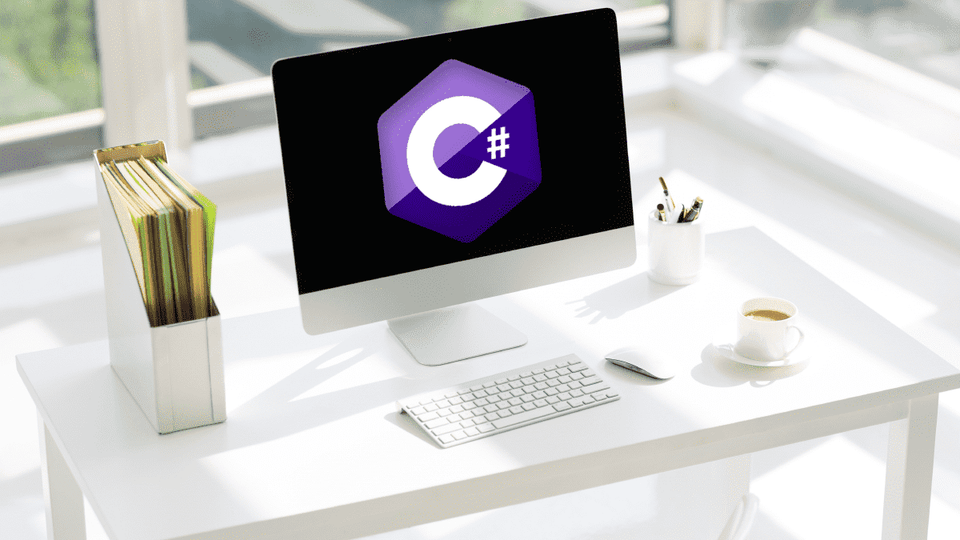
C#의 메모리구조를 살펴보면서 실제 C# 언어의 기본 문법을 학습하고 간단한 콘솔 프로그래밍을 개발하여 구조지향과 객체지향의 프로그래밍을 습득하는 것을 목표로 합니다.
이 강의를 듣고 나면 C# 언어의 내부 구조를 예상하여 개발 할 수 있게 됩니다. 다만 입문자의 경우 길게 잡고 하루 30분씩 꼭 연습이 필요합니다. 짧게는 2주에서 한달부터 길게는 3달까지 잡으시는 것이 좋습니다.왜냐하면 장기기억으로 쌓여야 이것이 당연한 것이 되어 생각한 대로 프로그래밍을 할 수 있게 됩니다. 유니티에 접근하는 초보자들이나 비전공자들에게 큰 도움이 될 것으로 생각합니다.
현재 강의는 약 10시간 분량이며 110개 정도의 강의로 이루어져 있습니다.
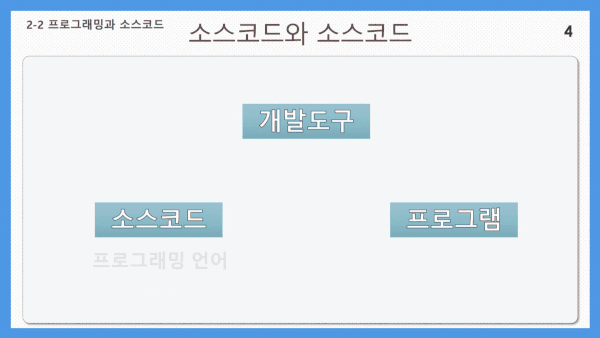
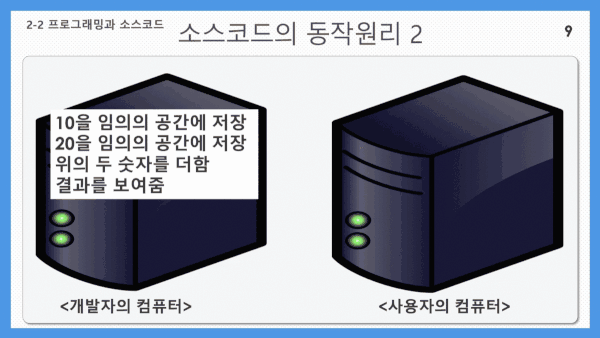
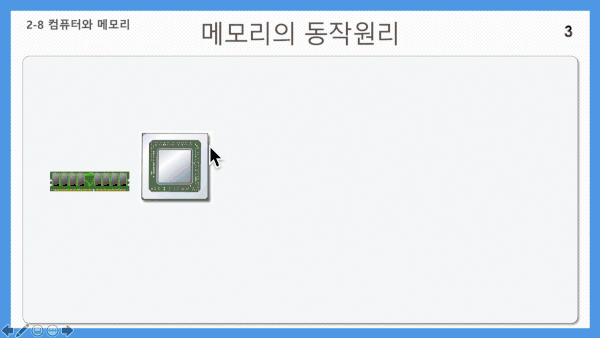
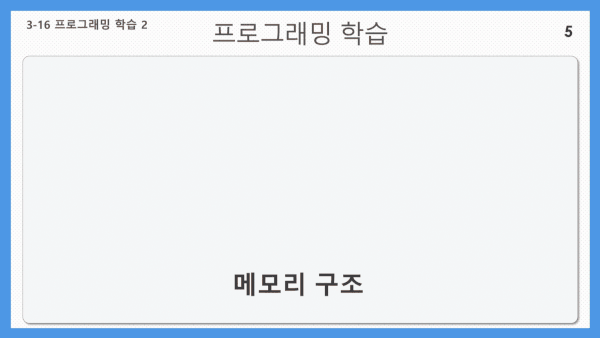
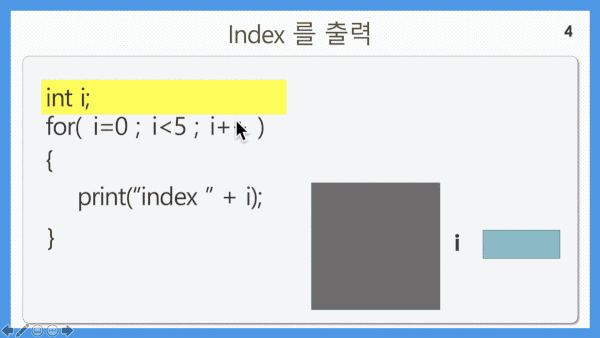
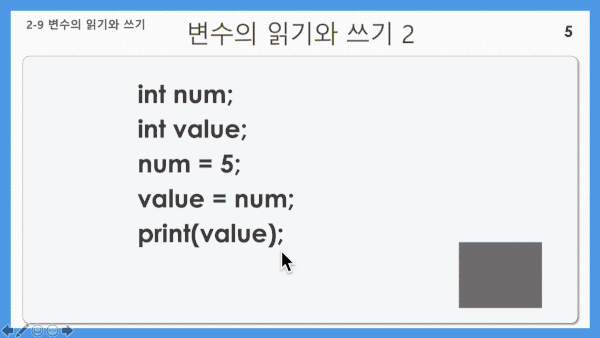
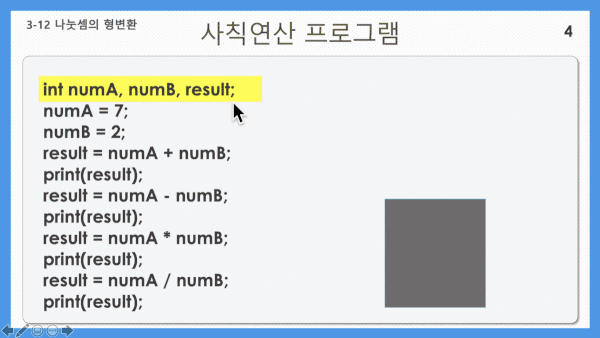
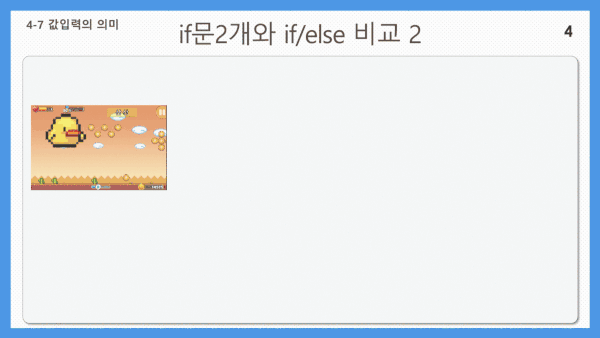
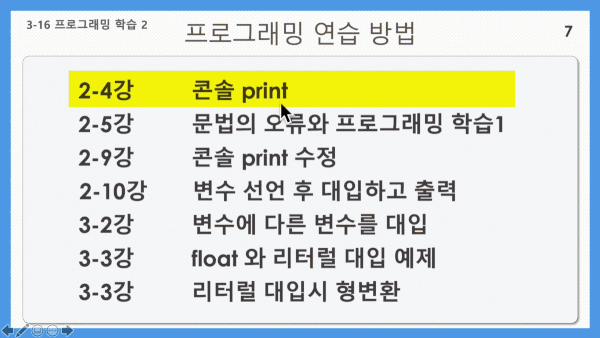
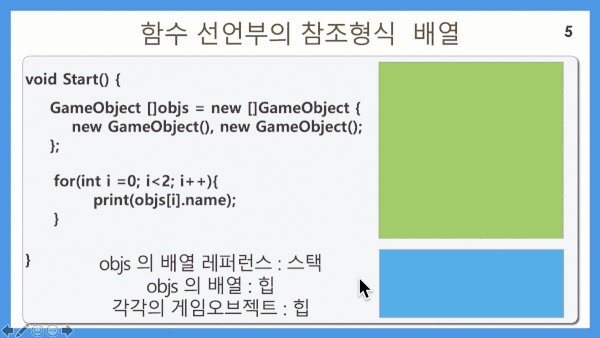
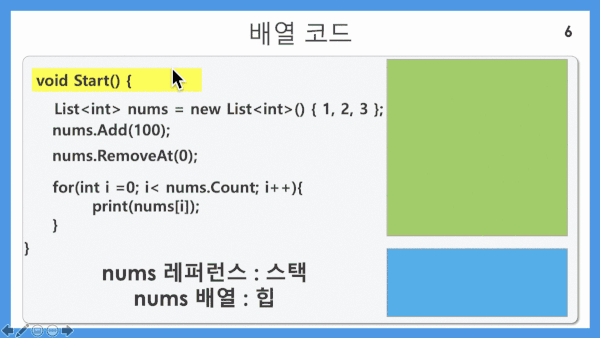
이 강의에서는 학습을 하시고 꼭 실습을 하시는 것이 좋습니다. 특히 비전공자는 평소에 프로그래밍으로 일을 하지 않기 때문에 그냥 보기만 해서는 절대 프로그래밍을 습득할 수 없습니다.
이해를 하시고 나서 필요한 핵심적인 내용을 암기하셔야 합니다. 그리고 실습해야 합니다.
에버노트를 사용하여 강의를 배울때 정리하는 법을 알려드립니다.
구글 스프레드시트를 이용하여 학습의 진행률을 볼 수 있는 방법도 알려드립니다.
간단한 내용들이지만 비전공자는 시간이 없습니다.(전공자도 마찬가지입니다)
최단 시간에 최적의 연습을 할 수 있는 방법을 설명해드립니다.
Q. 비전공자도 들을 수 있나요?
A. 네, 비전공자와 입문자가 들을 수 있도록 제작한 강의입니다. 전공자 분들에게는 조금 쉬울수도 있습니다만 메모리구조를 복습하는 차원에서도 들으시면 좋습니다.
Q. 이 "C# 프로그래밍"를 배우면 무엇이 좋은가요?
A. 원리를 알아야 응용이 가능합니다. 프로그래밍을 하는 것만이 아닌 오류를 잡을 때도 원리를 알아야 응용을 할 수 있습니다. 프로그래밍을 할 때 오류가 생긴다고 해서 다른 누군가가 문제를 해결해주지 않습니다. 원리를 알고 나면 오류를 수정할 수 있습니다. 또한 이해가 깊어져서 응용이 가능합니다.
Q. "C# 프로그래밍"의 강의를 들으면 어떤 일을 할 수 있나요?
A. 실제 유니티를 게임을 만들기 위한 준비가 가능합니다. 이 다음강의인 Part 3 의 슈팅게임개발의 강의를 들으실 수 있습니다. 또한 유니티로 다른 프로그램을 만들 때 큰 도움이 됩니다.
Q. 이 강의만의 특별한 장점이 있을까요?
A. 처음 볼 때는 어려울 수 있습니다. 하지만 그 단계를 넘어가서 중반 이상 가게 되면 원리에 대한 개념이 생깁니다. 내부구조를 알면 컴퓨터가 어떻게 동작하는지 소스코드가 어떻게 동작하는지를 예상할수 있습니다. 그렇게 되면 프로그래밍뿐만 아니라 디버그의 실력도 향상됩니다. 오류가 있어도 해결할 수 없다면 그것만큼 힘든 일이 없습니다. 이런 상황을 예방하기 위해 원리와 메모리에 대한 공부가 필요합니다.
학습 대상은
누구일까요?
코딩을 처음 접하는 분
게임을 개발하기에 앞서 유니티를 실행해보고 싶으신 분
선수 지식,
필요할까요?
폴더와 파일을 알고 컴퓨터를 사용할 수 있는 분
5,438
명
수강생
184
개
수강평
151
개
답변
4.9
점
강의 평점
4
개
강의
안녕하세요. UDevApp 의 최형선이라고 합니다.
무엇인가를 만들어낸다는 것은 정말로 행복한 일입니다.
세상에 나의 제품이 나올 때의 느낌은 스티브잡스가 느낀 그것이나
여러분들이나 저와 다르지 않다고 생각합니다.
여러분들에게 그러한 감정을 드리는 사람이 되고 싶습니다.
네이버카페와 블로그와 유튜브에도 많이 찾아와 주시길 바랍니다.
.
https://cafe.naver.com/ultimategunz(카페바로가기)
http://blog.naver.com/siwoo2406(블로그 바로가기)
https://www.youtube.com/user/ChoiHyungSun/(유튜브 바로가기)
감사합니다.
전체
111개 ∙ (12시간 22분)
해당 강의에서 제공:
1. 유니티 기본 기능 소개
00:47
2. 게임엔진
02:46
3. 통합개발환경
04:44
4. 유니티 다운로드와 프로젝트
07:22
5. 윈도우즈 유니티 다운로드
05:57
7. 프로젝터뷰, 인스펙터뷰
04:07
8. 씬뷰, 인스펙터뷰
05:18
9. 계층뷰
05:52
10. 게임뷰와 뷰들의 관계
04:05
11. 게임오브젝트의 소개
07:18
12. 컴포넌트
04:37
13. 스크립트 컴포넌트의 소개
05:20
14. 기초 C# 프로그래밍 소개
00:39
15. 프로그래밍과 소스코드
06:22
16. 콘솔 소개
04:37
17. 콘솔 프로그램
08:00
18. 문법의 오류와 프로그래밍 학습
06:14
19. 콘솔 프로그램의 순차
06:37
20. 빌드와 게임실행
08:00
21. 컴퓨터와 메모리
04:01
22. 변수의 기초
09:27
23. 변수의 읽기와 쓰기
09:35
24. 프로그래밍 작성시 사고방법
08:37
25. 변수를 선언하면서 대입
04:22
26. 자료형 소개
00:55
27. float와 리터럴
07:28
28. 리터럴 대입시 형변환
07:21
29. 리터럴 대입시 형변환 오류수정
05:51
30. 변수 대입시 형변환
06:23
31. 변수 대입시 형변환 오류수정
07:33
32. 두 수 더하기와 기계어
06:31
34. 논리적 오류와 수정
07:31
35. 디버깅
11:40
36. 사칙연산의 형변환
13:18
37. 나눗셈의 형변환
12:33
38. 다른 형태의 변수
11:41
39. 변수의 이름규칙
03:58
40. 평균을 구하는 프로그램
05:19
전체
33개
4.8
33개의 수강평
수강평 1
∙
평균 평점 5.0
5
프로그래밍 처음해보는 초보자들이 다른강의에서는 설명이 어정쩡해서 애매하게 이해하다가 어느순간부터는 대강 이해는 하는거같은데, 뭔가 애매하고 찜찜한 상태로 일단 진도를 나가야해서 완전이해를 못하고 넘어가는게 많은데, 이 강의는 전혀 다름. 시각이미지 애니메이션까지 총동원해서 작동원리까지 확실하게 이해하면서 넘어갈수있게 해줌. 시각적으로도 각인해줘서 이게 머리속에 더 쉽게 각인됨. 다른강의도 적당히 시각적 이미지를 사용하는데, 이강의는 그 시각적 이미지화가 독보적으로 뛰어나게 만들었음. 근본이 다른 시각화임. 단순히 이미지 시각화몇장이 아니라, 과정 자체의 시각화임 이게 어느정도냐면, 코드를 해석할때, 머릿속에서 그 과정이 이미지화 되는 수준임. 이게 되고 안되고가 진짜 엄청난 차이가 됨. 전에 다른 입문강의에선 체험 못한 결과임. 이는 아마 이 강의를 기획 할 때부터 이부분의 중요성을 염두한거라 보여짐, 그렇지 않고선 타 강의와 압도적으로 차이날 정도로 세세한 애니메이션을 다 구현하면서까지 시간과 공을 들여 신경쓸리가 없음. 또한 강의를 1회 정독만해도 핵심인 부분은 자연스럽게 여러번 반복해서 이해하고 각인하게끔 치밀하게 설계되어 있는 꼼꼼하고 훌륭한 강의. 초보들이 복습 제대로 안하는거까지 염두하고, 치밀하게 설계한 느낌임.. 실제로 효과가 어마무시함. 솔직히 초심자용이라고 하는 다른 강의들은 대부분 보다가 중후반부터 접었는데, 그 이유가 초반에는 너무 쉬워서 다 이해하다가, 중반부터는 조금씩 이해 안되는 부분들이 생기면서 대강은 이해하는데, 애매하게 이해한것들이 쌓이고 누적됨. 그러면, 결국엔 이런것들이 비수가 되어서 후반부 부터는 뭔소린지 이해 못한채, 그냥 따라하며 코드 받아쓰기 수준이됨. 강사들도 후반에는 그냥 이렇게 쓰세요 수준의 무성의함이 대부분... 예를들어 초반에 변수선언 설명할때는 입문자용 강의답게 꼼꼼하게 설명하던 강사가 중반쯤 새로 등장하는 개념인 함수설명할때는 함수의 구조등등의 설명 대충하고 건너뜀.. 아니 분명 함수도 새로등장한 개념이라 확실한 이해가 필요한 중요한 내용인데, 뭔가 강의 초반의 입문자를 대하던 그 느낌의 설명이 아님 ㅋ. 수강생들은 완강하기전까진 아직 입문자인데, 강사입장에서는 이쯤되면 이런거 꼼꼼히 설명안해도 알아듣겠지~ 싶은걸지도 모르겟으나, 실제로 입문자들은 입문강의초반이 어려운게 아니라 중후반이 더 어려움. 근데 강사는 이제 강의후반되면 강의를 빨리 마무리 짓고싶은건지, 강의내용이 점점 무성의해지고, 꼼꼼함과는 거리가 멀어짐... 이게 대다수 입문자용 강의의 패턴임. 결국 나중엔 대체 얘는 왜 이렇고 얘는 왜이런지 그 작은 부호 하나의 의미까지 헷갈리는 순간까지 오는데, 그쯤부터 슬슬 포기하게됨. 이러한 이유로 보다가 초반이나 중간에 떄려친 강의가 3~4개 정도 됨. 이게 탑클래스의 좋은 강사가 아니면, 본인은 당연하게 생각하는 많은 개념이나 활용기술들이 초심자에게는 얼마나 헷갈릴지 어느수준의 꼼꼼한 설명이 필요한지 감을 잡기 어렵기 때문이라고 생각함. 자기가 잘하는거랑 남이 잘할수 있게 가르치는거랑은 전혀 다른거라서, 대부분의 평범한 강사들은 초보를 위한 강의를 해도 자신도 모르게 이런부분을 군데 군데 놓치게 되는거라고 생각함. 근데 이게 무서운게, 군데군데, 그렇게 구멍난 이해도가 나중엔 비수처럼 다가와서 뒤죽박죽이되고, 포기하게됨. 결국, 그런 강의들은 사실은 진짜 초심자용이 아니었던 거 같음, 진짜 초심자가 개념을 확실히 다질수 있는 꼼꼼한 강의는 이게 처음. 신기하게도 이 강의에서는 초보자입장에서도 애매하게 이해해서 찜찜하게 넘어가는거 없이 아직까진 완전히 이해하면서 진행중. 기존에 접해본 초보 입문자용 강의라고 하는 것들이랑 질적으로 아주아주 많이 다름. 아마 다른 입문자용 강의 겪어보고 이강의 듣는 수강생은 이강의가 얼마나 압도적으로 뛰어나고 근본이 다른 강의인지 뼈저리게 느낄것이고, 이강의로 처음 입문하는 수강생은 자신의 능력이 뛰어나서 강의내용을 잘 이해하는 거라 착각하며 으쓱해 할거라는 생각이 듬. ㅋㅋ 일년에 리뷰는 잘해야 한두번 남기는 내가 리뷰 달 정도면 말 다함. 고마워서 남김. 이런분이 계속 좋은 강의 더 많이 올려주시길 바랄뿐임.
정말 꼼꼼하고 정성스러운 수강평에 너무 감사드립니다 말씀하신대로 설계하고 난의도 조절하면서 설계해서 만든게 맞습니다 알아주시고 이해하셨다니 정말 저도 힘이 나는것 같습니다 ^^ 실제로도 큰 힘이 되고요 이강의도 계속 보강하고 다른 더 좋은 강의 만들겠습니다 정말 감사합니다 나중에 더 수정해서 적도록 하겠습니다 감사합니다
수강평 4
∙
평균 평점 5.0
5
백번듣느니 한번 보는 만 못하다는 말이 정말입니다. 백문이 불여일견이라는 한자성어가 딱이네요. 그림으로 코드의 내부구조를 그려서 하나하나 설명해주니 정말 쉽게 알아듣겠습니다. 왜 이런강의가 지금까지 없었나 싶기도 하고요. 열심히 듣고 잘 배우겠습니다. 어려운 내용을 이해할 수 있도록 좋은강의 만들어주셔서 감사합니다. 계속적으로 좋은 강의 올려주실거죠? ㅎㅎ 기대하겠습니다 감사합니다.
좋은 수강평 너무 감사드립니다. 이해하기 쉬운 강의로 더 많이 만들도록 하겠습니다. ^^
수강평 2
∙
평균 평점 5.0
5
초보자나 비전공자가 기초부터 탄탄하게 다져가며 시작하기에 정말 좋은 강의입니다. C# 문법을 다른 강의들처럼 순서대로 배우는 것이 아니라 컴퓨터 메모리 구조에 따라 어떻게 작동하는지 아주 간단명료하게 가르쳐 주셔서 이해하기 쉽습니다. 그리고 각 단원 강의가 10분 내외로 구성되어 있어서 하루에 공부할 양이 부담이 없습니다. 선생님께 질문드리면 답변이나 피드백도 빨라서 좋구요. 무엇보다 선생님께서 운영하시는 카페에서 다양한 정보와 교류를 통해 게임 개발이라는 주제로 소통할수 있어 더 동기부여가 됩니다. 프로그래밍 입문 강의를 시작으로 슈팅게임 개발 강의와 이후에 올라올 프로토타입 강의들까지 이 커리큘럼만 꾸준하고 성실하게 따라간다면 어느새 어엿한 1인 게임개발자가 되어 있을거라고 확신합니다.
좋은 수강평 너무 감사드립니다. 공부 열심히 하셔서 좋은 결과 이루시길 바랍니다. 더 좋은 강의 만들도록 하겠습니다. ^^
수강평 8
∙
평균 평점 4.9
5
솔직히, 어떤 프로그래밍 강의도 이렇게 비전공자에게 쉽게 설명 할수 있는 강의는 드물 것이라고 생각합니다. (저도 비전공자로 swift로 아이폰앱개발로 처음 시작하긴 했지만) 제가 만약 이런강의로 프로그래밍을 입문했다면 프로그래밍이 훨씬 쉽게 느껴졌었을 것 같습니다. 취미로 게임 하나 개발해 볼까? 가볍게 시작하긴 했지만.. iOS개발에도 또 도움이 되는 부분도 많네요. (게임루프, 메모리 구조 등) 그만큼 기초를 단단하게 다져주시는 강의라 정말 만족합니다. 별5개가 아니라 별 10개 드리고 싶습니다. 정말 단순한 관심에 취미로 단순히 시작했는데.. (이제 본 강의 C#문법 70%정도 끝냈지만..) 빨리 다음 강의도 끝내서 정말 슈팅게임까지 만들어서 앱스토어에 등록해 봐야겠네요ㅎㅎ 정말 감사합니다. 강사님 :)
좋은 수강평 정말로 감사드립니다. 아직 완료되지 못한 강의들이 있는데 빨리 올리기에는 퀄리티가 떨어질거 같아서 천천히 올라가게 되네요. 최대한 빨리 올리도록 하겠습니다. 감사드리며 좋은 강의 더 만들도록 하겠습니다. ^^
수강평 2
∙
평균 평점 5.0
인프런 10주년! 사랑주간 전체 할인 중 (7일 남음)
월 ₩226,808
5개월 할부 시
29%
₩77,000
₩1,134,042
지식공유자님의 다른 강의를 만나보세요!
같은 분야의 다른 강의를 만나보세요!